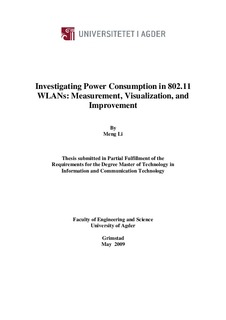| dc.description.abstract | 802.11 based wireless local area network (WLAN) has been increasingly supported by
handheld devices. However, supporting WLAN functionality is extremely energy consuming
since the connectivity has to be maintained even when the device is in an idle
state. The power management specified in the 802.11 standards do not specify detailed
techniques to handle the problem caused by power consumption affecting factors
(PCAFs), since most of these factors have not been specified in the standards.
The objective of this master dissertation is to investigate how different PCAFs affect the
power consumption in 802.11 WLANs.
As a starting point, several PCAFs are identified and investigated, including the beacon
period, the beacon size, the signal strength, the foreground traffic, the background traffic,
and the delivery traffic indication map (DTIM). Following the test instructions specified
for both an idle mode and a traffic mode, measurement data for these two modes have
been collected from the test-bed. According to the experimental study, it has been shown
that all the PCAFs have different qualitative and quantitative effects on the power consumption
of 802.11 WLANs. For example, the uplink traffic mode consume more energy
that the downlink one. The background traffic eliminates the effectiveness of the power
management the most among all PCAFs.
By making use of the findings from the experimental study combined with the concept
of 802.11 theory, analytical expressions for calculating the power consumption under a
802.11 legacy polling scheme are derived. The accuracy of the obtained equations have
been validated by the experimental data measured from the test-bed.
Moreover, a WLAN Power visualization tool (WPVT) has been implemented by Java,
which can display theoretical power consumption curves for both an idle mode and a
traffic mode if PCAF configurations are fixed. All theoretical curves are determined according
to the derived analytical formula. Different with the traditional way where a
test-bed, hardware configurations, multimeter testing, etc., are required, the WPVT only
needs simple PCAF configurations. In a sense, the WPVT facilitates the investigation of PCAFs in 802.11 WLANs due to the fact of less time consuming as compared with the
traditional experimental study.
Finally, a new power saving algorithm has been proposed, which has taken the time drift
of the synchronization clock between an access point (AP) and a station (STA) into account.
Probability density function (PDF) curves of the power consumption have been
presented and simulated for both the Legacy polling scheme and the new mechanism. It
turns out that the new mechanism outperforms the Legacy polling scheme with respect
to the power consumption.
The investigation presented in this dissertation provides first-hand empirical results and
guideline for studying PCAFs in the 802.11 WLANs. Both the methodologies and the
investigation results can supplement existing prior research work related to power conservation
topics. This is the main potential outcome through the thesis, which can also
act as the main contribution to knowledge. | en |
